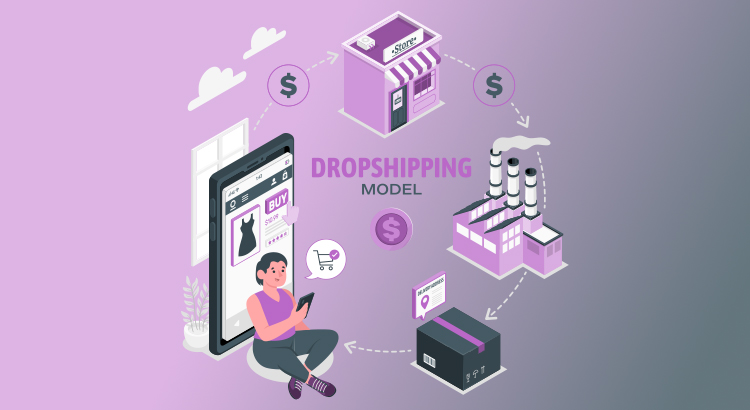You might wonder what dropshipping is when exploring ways to start an online business with minimal cost. It’s a retail model where you sell products without keeping any inventory. You list items on your online store, but the products come directly from a third-party supplier.
When someone makes a purchase, the order is forwarded to that supplier, who handles packaging and shipping. This model is common in ecommerce dropshipping businesses and appeals to sellers who want to avoid managing stock.
What is Dropshipping?
Dropshipping is a fulfillment approach used by online sellers to offer products without storing them in-house. Instead of holding inventory, these sellers work with dropshipping suppliers who take care of product storage and delivery. You act as the storefront, while the supplier handles the logistics.
This online dropshipping setup lowers financial risk, speeds up business launch time, and allows for broad product listings. It’s one of the most accessible ways to start dropshipping and build an ecommerce business.
What Are Dropshipping Suppliers?
Dropshipping suppliers are the backbone of any dropshipping business. They source, stock, and ship products on behalf of online retailers. Some are individual wholesalers or manufacturers, while others operate through supplier platforms or apps that integrate directly with ecommerce stores.
Suppliers play a key role in ensuring reliable dropshipping fulfillment. They may offer services like branded packaging or quicker shipping times, helping your store provide a better customer experience. Platforms like AliExpress connect you to a wide range of global dropshipping partners.
7 Benefits of Dropshipping
Dropshipping has become a go-to model for ecommerce entrepreneurs. Here are seven reasons why:
1. Low Startup Costs
You don’t need to buy inventory upfront, rent warehouse space, or invest heavily in logistics. This makes dropshipping for beginners especially attractive. All you need is a laptop and an internet connection to get started.
2. Sell a Wide Range of Products
With no physical stock limitations, your product catalog can be as broad as your niche allows. You can quickly adapt your product list based on trends, seasons, or customer demand.
3. No Need for Product Development
You’re selling items that are already made and often already in demand. Product dropshipping eliminates the need for expensive research and development.
4. Work from Anywhere
A dropshipping business can be managed from home, a coffee shop, or even while traveling. As long as you stay connected with your suppliers and customers, your location doesn’t matter.
5. Simple to Launch
Compared to traditional retail, online dropshipping is easier to get off the ground. There’s no need to worry about storage, packing, shipping, or managing returns, especially when using automated tools.
6. Great for Product Testing
Want to try out a new product category? Dropshipping lets you test interest with little risk. If a product doesn’t sell, you simply remove it from your store without losing money on unsold stock.
7. Scales Easily
As order volume grows, your supplier handles the increased workload. This scalability makes it easier to grow your online dropshipping business without needing more staff or space.
How Does Dropshipping Work?
To understand how dropshipping works, you need to follow a clear process that explains how orders move from your store to the customer. The process is explained below:
1. Choose a Dropshipping Supplier
Start by selecting a supplier that offers the types of products you want to sell. Once you establish a working agreement, the supplier takes responsibility for storing inventory, packing products, and shipping them directly to your customers.
You can work with a single supplier in your niche or use a dropshipping platform that connects you to multiple vendors.
2. Launch Your Online Store
Create your ecommerce store and list the products from your supplier. You set the selling price, while the supplier handles the logistics.
To streamline operations, integrate a dropshipping app with your store. These apps ensure product details stay updated and automatically send orders to the right supplier.
3. Accept Customer Orders
When a customer places an order through your website, the checkout process runs as usual. The customer makes the payment, receives an order confirmation, and waits for their package.
4. Forward the Order to the Supplier
Once the order is confirmed, the details are sent to your supplier. If you’ve installed a dropshipping app, this step typically happens automatically, saving you time and effort.
5. Supplier Fulfills and Ships the Order
The supplier prepares the product and ships it directly to your customer. Some suppliers even offer features like branded invoices or custom packaging to help enhance your brand’s presence.
6. Product Delivery and Customer Support
The product reaches the customer without ever passing through your hands. You remain in charge of handling customer service, addressing any issues, or managing returns if needed.
In a Nutshell
The dropshipping model is built around simplicity and flexibility. This setup allows you to operate a retail business without the need for a warehouse or upfront inventory costs. It’s a popular choice for ecommerce beginners and expert entrepreneurs alike because it’s easy to start and can grow without needing a lot of money or resources.


